Table of Contents
How to Improve Your Grades by Understanding Where You Stand
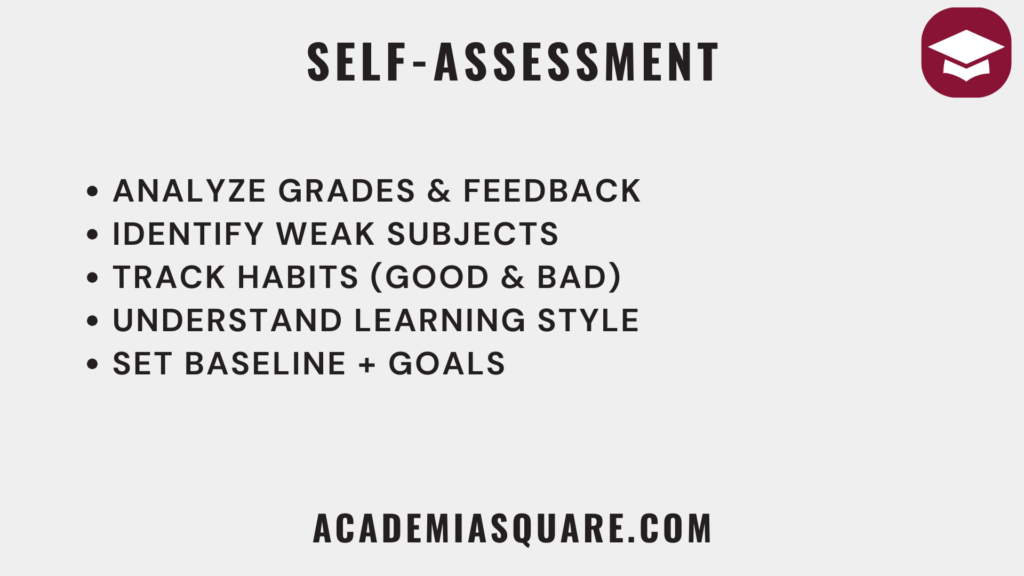
Before you can figure out how to improve your grades, you need to understand exactly where you stand. Many students feel lost academically because they haven’t taken the time to reflect on their performance. Self-assessment is the first step toward meaningful progress—and it’s one too often overlooked.
Why Self-Assessment Matters
To get better grades fast, you need clarity. Without knowing your strengths and weaknesses, you might waste time studying inefficiently or focusing on the wrong areas. According to research from the University of Nebraska, students who regularly assess their academic habits tend to develop more effective strategies and report higher GPAs over time.
Self-assessment allows you to:
- Identify specific subjects or topics you struggle with
- Recognize patterns in your academic performance (e.g., test anxiety, weak essay writing)
- Understand which habits contribute to your success—and which sabotage it
Start With Your Grades
Begin by gathering all your recent report cards, test scores, and feedback from teachers or professors. Don’t just glance—analyze. What are your average grades per subject? Do you see a downward or upward trend? What do teachers say about your performance in comments?
Ask yourself:
- Which subjects consistently show low scores?
- Am I losing points due to incomplete assignments or poor test results?
- Is my performance inconsistent—strong on one assignment, poor on another?
Use a spreadsheet or even a notebook to record these observations. Seeing your progress (or lack thereof) in visual form can be a powerful motivator.
Evaluate Your Study Habits
Your current study habits are directly tied to your academic performance. A student who doesn’t plan study sessions, reviews material only before exams, or multitasks while learning is unlikely to get the best results. If you want to truly learn how to improve your grades fast, you must identify and correct these inefficiencies.
Here’s a checklist to evaluate your current habits:
- Do I have a consistent daily or weekly study routine?
- Do I review class material regularly or only during exams?
- Am I easily distracted while studying?
- Do I take active notes or just passively read?
- Do I ask questions in class or seek clarification when confused?
Know Your Learning Style
Some students learn best by seeing (visual learners), others by hearing (auditory learners), and some by doing (kinesthetic learners). Knowing your learning style can give you an edge in creating effective study techniques. For example, if you’re a visual learner, mind maps and color-coded notes might help. If you’re auditory, recording lectures or listening to podcasts may improve retention.
While research on learning styles is mixed, there’s strong evidence that personalized learning boosts motivation and memory. In short: when you study in a way that fits you, you tend to remember more—and score higher.
Create a Baseline and Set Specific Goals
Once you’ve reviewed your academic data and habits, set clear, achievable goals. Don’t just say, “I want better grades.” Say, “I want to raise my math grade from a C to a B by the next report card.” Setting measurable objectives like these provides direction and keeps you accountable.
Write down your baseline scores, define where you want to be, and add a realistic timeline. You’ll use these goals to shape your strategies in the upcoming chapters.
The path to getting better grades starts with honest self-reflection. When you know what’s working—and what isn’t—you can take targeted action. This chapter lays the foundation for all the improvements that follow.
Time Management Strategies to Improve Your Grades Fast
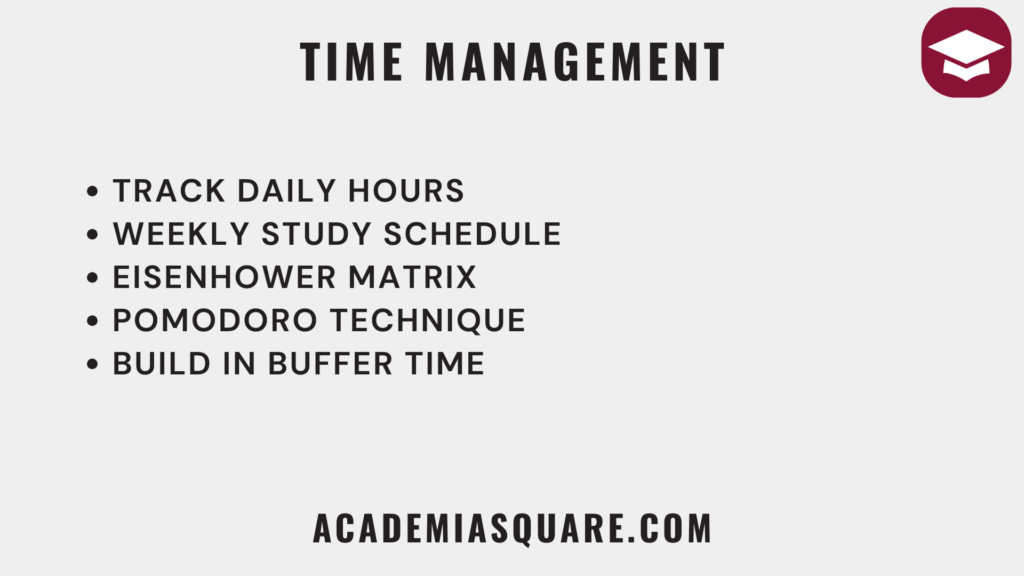
If you’re wondering how to improve your grades fast, time management is one of the highest-impact changes you can make. Many students don’t perform poorly because they lack ability, but because they waste valuable hours each day. In fact, a 2022 study by the American Psychological Association found that effective time management is one of the top predictors of academic success.
Mastering your schedule helps you avoid last-minute cramming, reduces stress, and builds a routine where studying becomes second nature. Whether you’re in high school or college, building these habits now pays off both academically and professionally.
Why Time Management Matters for Grades
Without proper structure, your academic life can quickly become chaotic. Missed deadlines, rushed assignments, and inconsistent study sessions all contribute to low performance. Learning how to get better grades means first learning how to make time for the things that matter most.
When you manage your time well, you benefit from:
- Improved focus during study sessions
- Higher-quality work with fewer errors
- More free time for rest and activities—without guilt
- Lower stress levels as you gain control over your schedule
Step 1: Track How You Spend Your Time
You can’t improve what you don’t measure. Start by tracking a typical week: how much time do you spend on classes, studying, commuting, eating, working, and relaxing? You might be surprised at how many hours disappear to scrolling, gaming, or passively watching TV.
Use a simple notebook or a time-tracking app like Clockify or Toggl. After a week, review the data. Which hours are underused? Where could you build in regular study blocks?
Step 2: Create a Weekly Study Plan
Once you know your patterns, create a weekly schedule that includes:
- Class time and assignments
- Daily study sessions (aim for 25–50 minute blocks)
- Breaks and rest periods
- Sleep, exercise, and social time
Use the time-blocking method: assign specific activities to specific hours. Treat study sessions like appointments—non-negotiable and protected. Tools like Google Calendar or Notion can help you organize this visually.
Step 3: Prioritize Tasks Using the Eisenhower Matrix
Not all tasks are equally important. The Eisenhower Matrix helps you separate what’s urgent from what’s important. Here’s how it works:
- Urgent + Important: Do it now (e.g., an assignment due tomorrow)
- Important but Not Urgent: Schedule it (e.g., long-term studying for finals)
- Urgent but Not Important: Delegate or minimize (e.g., social obligations that can wait)
- Not Urgent + Not Important: Eliminate or reduce (e.g., scrolling TikTok aimlessly)
When you plan around importance instead of urgency, your academic life becomes proactive—not reactive.
Step 4: Use the Pomodoro Technique
The Pomodoro Technique is a popular study method where you work for 25 minutes, then take a 5-minute break. After four “Pomodoros,” you take a longer 15–30 minute break. This approach boosts focus and helps combat mental fatigue—especially for students who struggle with procrastination or ADHD.
You can use apps like Forest or Pomofocus to guide you through each cycle. Even just two Pomodoro cycles a day can have a significant impact on your ability to get better grades quickly.
Step 5: Build in Flexibility
Life happens—assignments change, emergencies come up. That’s why the best schedules include “buffer time.” Plan for at least one hour a day of open time that can absorb surprises. This helps you stay on track even when things don’t go perfectly.
Lastly, don’t forget to review your schedule weekly. What worked? What didn’t? Time management is a living system—you refine it as you go.
In mastering your time, you’re not just managing hours—you’re taking control of your academic future. Whether your goal is passing a tough class or landing a scholarship, this is one of the most powerful steps toward learning how to improve your grades—fast and for the long term.
Effective Note-Taking Methods to Get Better Grades
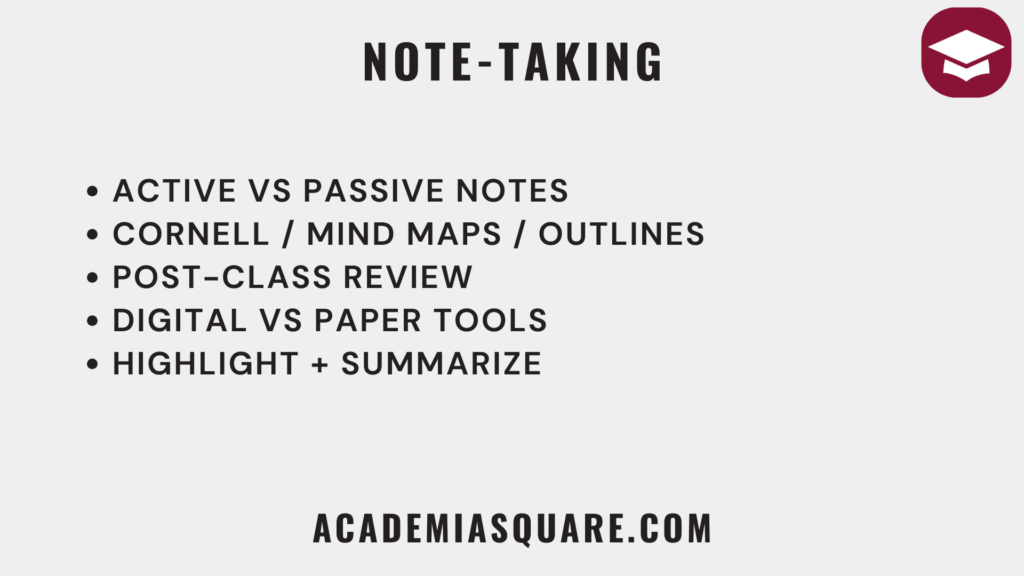
When students ask how to improve your grades, one of the most overlooked but powerful answers is: improve your note-taking. Taking effective notes doesn’t just help you retain information—it also helps you think critically, stay organized, and prepare for exams efficiently. Yet many students rely on passive methods like copying slides or writing everything the teacher says verbatim. These habits lead to shallow understanding and poor recall.
According to research published in the journal Memory, students who engage in active note-taking outperform those who don’t—especially when notes are later reviewed and reorganized. Let’s explore how to transform your notes into a strategic learning tool.
Why Note-Taking Affects Your Grades
Note-taking forces your brain to process and organize information in real-time. This immediate engagement boosts both comprehension and memory. When you later review and interact with your notes, you reinforce those learning pathways—improving recall when it matters most: during tests and assignments.
More than just a memory aid, good notes also:
- Highlight what’s important and what isn’t
- Help you prepare faster for exams
- Track what concepts still need clarification
- Reduce stress by organizing complex information clearly
Popular Note-Taking Methods (And When to Use Them)
Different formats suit different learners and subjects. The method you choose should depend on how your classes are structured and how you best retain information. Here are three of the most effective systems:
- The Cornell Method: Divide your page into three sections: notes, cues, and summary. This system promotes review and critical thinking. Ideal for lectures heavy on facts and definitions.
- Mind Mapping: A visual method that organizes ideas around a central concept. Excellent for brainstorming, conceptual subjects, or visual learners.
- Outlining Method: A structured, hierarchical format that breaks down main ideas and subpoints. Perfect for subjects like history, literature, or any course that follows linear logic.
Don’t be afraid to mix methods. You might use mind maps for brainstorming, Cornell for class, and outlines for reviewing textbook chapters. The goal is to engage actively with the material, not just transcribe it.
Active vs. Passive Note-Taking
Passive note-taking = copying. Active note-taking = thinking while writing. To get better grades, your notes must be alive. This means rephrasing ideas in your own words, drawing connections between concepts, and adding questions or comments in the margins.
Here are signs your note-taking is active and effective:
- You write down questions you think of during the lecture
- You paraphrase ideas instead of quoting them word-for-word
- You draw arrows, highlights, or symbols to link related topics
- You leave space to return later and add extra info or answers
Reviewing and Organizing Notes After Class
Taking notes is only half the equation. What you do with them afterward can make or break your academic performance. Within 24 hours of class, review your notes and fill in any gaps. Rewrite or reorganize messy sections. Highlight key terms and write brief summaries at the bottom of each page.
This active review process reinforces learning and turns your notes into a personalized study guide. According to a 2020 study from the Journal of Educational Psychology, students who review their notes within one day of taking them increase their test performance by up to 25% compared to those who don’t.
Digital vs. Handwritten Notes: What’s Better?
Both have pros and cons. Handwritten notes are slower but improve retention and understanding—especially for conceptual material. Typing is faster and more convenient, particularly for fast-paced lectures or classes with lots of information. If you type, avoid just transcribing; format, highlight, and annotate as you go.
Some tools to consider:
- Notion or Evernote: Great for organizing long-term digital notes
- OneNote: Excellent for combining typed and handwritten notes
- Google Docs: Ideal for collaboration or shared class outlines
At the end of the day, the best note-taking method is the one that helps you engage, organize, and review the material in a way that makes sense to you. If you’re serious about how to improve your grades, mastering this skill is non-negotiable. Your notes should be your #1 study weapon—not just a pile of paper you never look at again.
Active Learning Techniques That Improve Your Grades Naturally
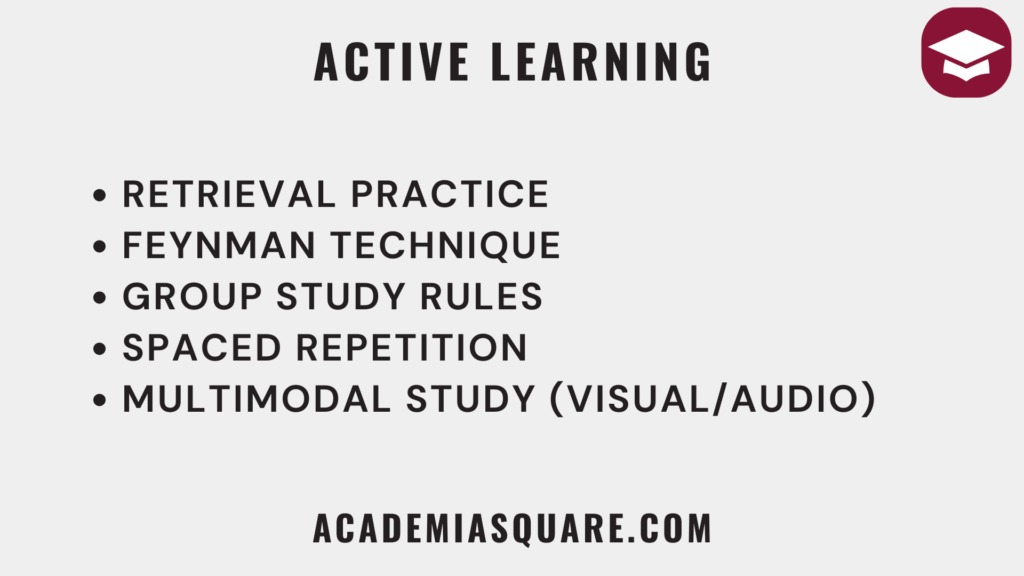
If you’ve been relying on rereading notes or highlighting textbooks to study, it’s time to rethink your strategy. Passive learning might feel productive, but it’s one of the least effective ways to retain information. To improve your grades fast, you need to shift from passive to active learning techniques. These strategies not only deepen your understanding—they also help you retain information longer and apply it more effectively in tests and real-world situations.
Active learning is supported by decades of educational research. According to a comprehensive meta-analysis published in Proceedings of the National Academy of Sciences, students engaged in active learning outperform those in traditional lecture-based environments across nearly every academic field.
What Is Active Learning and How Does It Improve Your Grades?
Active learning is any approach where you’re directly involved in the process—doing, creating, discussing, teaching, or solving problems. Instead of just absorbing information, you actively interact with it. This level of engagement forces your brain to organize knowledge, make connections, and reinforce memory.
Examples of active learning include:
- Explaining a concept to a classmate
- Answering practice questions
- Teaching the material out loud to yourself (“Feynman Technique”)
- Working on real-world problems or case studies
- Turning notes into diagrams, flashcards, or charts
These methods are far more effective than rereading or listening alone—especially when spaced out over time.
Use Retrieval Practice to Improve Your Grades
Retrieval practice involves recalling information from memory without looking at your notes or textbook. This forces your brain to work harder—and that’s a good thing. It’s like a workout for your memory. Numerous studies have shown that students who practice retrieval retain information much more effectively than those who don’t.
Here’s how you can incorporate retrieval practice into your routine:
- Use flashcards (apps like Anki or Quizlet are great)
- Cover your notes and try to write them from memory
- Answer end-of-chapter questions without looking back
- Use self-generated quizzes weekly
It may feel frustrating at first—but that struggle is what makes learning stick. This technique is one of the most powerful tools if you’re aiming to get better grades without spending extra hours studying.
How Group Study Can Help You Improve Your Grades
Studying with others—if done right—can deepen your understanding. Teaching classmates, discussing different perspectives, and debating answers exposes you to new ways of thinking. Just make sure the group stays focused and has a clear plan.
To make group study effective:
- Limit the group to 3–5 members
- Assign roles (e.g., timekeeper, note-taker, presenter)
- Rotate who teaches a topic to the rest of the group
- Keep sessions under 90 minutes and review progress at the end
Teaching someone else is often the best test of whether you truly understand something. If you can explain it simply, you know it well.
Incorporate Spaced Repetition to Reinforce Learning
Spaced repetition is a method where you review information at increasing intervals over time. Instead of cramming, you space out your study sessions, which leads to better long-term retention. This approach is based on the forgetting curve discovered by Hermann Ebbinghaus, which shows how quickly we forget things unless they are reinforced.
Use this simple schedule:
- Day 1: Learn the concept
- Day 2: Review with flashcards or quiz
- Day 4: Review again, focus on weak points
- Day 7: Quick recap and test
- Day 14: Final review before test
This method is easy to implement using tools like Anki or a paper calendar, and it’s ideal for improving retention across subjects.
Use Multimodal Techniques to Get Better Grades
We retain more when we engage multiple senses. Combine reading with writing, listening, speaking, or drawing. For example, read a section out loud, then summarize it in a diagram. Or listen to a podcast about a topic you just read. The more ways your brain processes the information, the deeper the learning.
Here are a few combinations that work well:
- Watch a short educational video and then draw a summary chart
- Record yourself explaining a topic and listen back
- Create a study poster using visual cues and key terms
If you want to improve your grades efficiently, engaging your brain in different modes is one of the smartest strategies available. It also makes studying more dynamic and less monotonous.
Active learning is about doing, not just absorbing. Once you adopt even a few of these methods, you’ll notice a tangible difference in how much you remember—and how much faster you can improve your academic results. You’re not just working harder—you’re working smarter.
Optimizing Study Environments
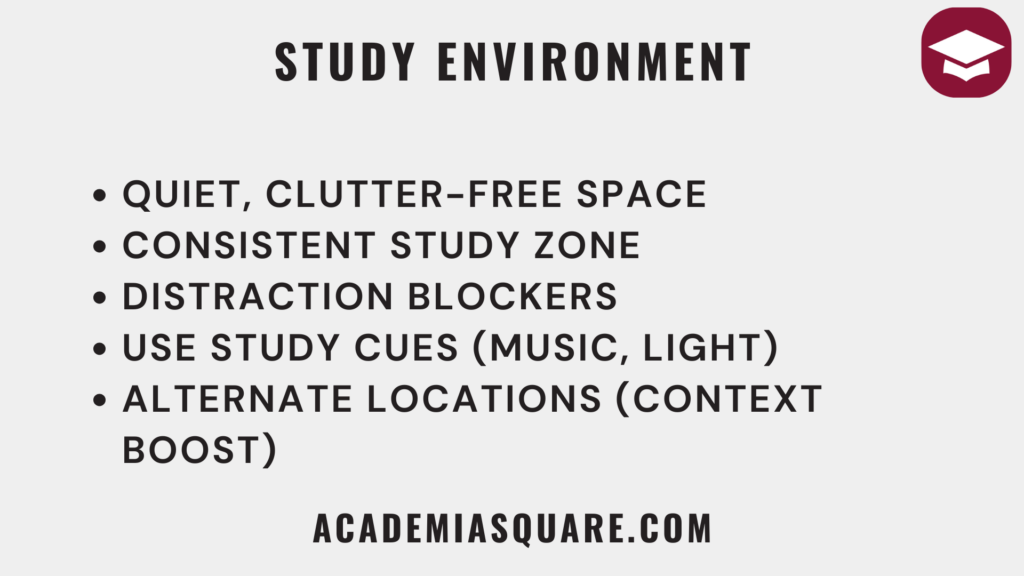
Even the best study strategies can fail if your environment works against you. If you’re serious about learning how to improve your grades fast, one of the most underrated tactics is setting up a space that supports focus, productivity, and mental clarity. Your brain is deeply affected by your surroundings—whether you realize it or not. A cluttered desk, loud background noise, or poor lighting can lead to distractions and decreased academic performance.
According to research from Princeton University, physical clutter in your surroundings competes for your attention, resulting in decreased performance and increased stress. Let’s look at how to design a space that helps—not hinders—your efforts to get better grades.
Why Your Study Environment Matters When You Want to Improve Your Grades
Your brain craves consistency. Studying in the same quiet, organized space every day creates a mental association between that location and productivity. Over time, simply sitting in that spot can help signal to your brain: “It’s time to focus.” This kind of environmental cue builds powerful study habits with less effort.
Here’s what an optimized study space does:
- Reduces mental fatigue and distraction
- Improves focus and attention span
- Boosts motivation through environmental consistency
- Makes transitions into deep work easier and faster
Checklist for Creating a High-Performance Study Space
Use the checklist below to audit or set up your environment for maximum academic impact:
- Quiet Location: Choose a space with minimal background noise. If noise is unavoidable, use noise-canceling headphones or ambient sound apps like Noisli.
- Comfortable Seating: A good chair with back support matters for focus and long-term health.
- Clutter-Free Desk: Keep only essential items on your desk—laptop, notebook, pen, water bottle. Clutter = cognitive drain.
- Lighting: Natural light is best. If studying at night, use a warm desk lamp to reduce eye strain.
- Good Airflow: A stuffy room reduces alertness. If possible, keep a window cracked or use a fan.
If you can’t control your surroundings (e.g., noisy roommates or small living space), consider studying at a library or using a designated corner of a room that you only use for schoolwork.
Use Environmental Cues to Get Better Grades
One effective psychological trick is to associate specific cues with focus. This technique is rooted in classical conditioning. For example, lighting a specific candle, playing a low-volume instrumental playlist, or wearing blue-light glasses can become your “switch” into study mode.
Over time, these cues act like a mental shortcut to boost concentration and reduce resistance to starting. They also help separate study time from leisure, especially important if you’re studying in a bedroom or shared living space.
Minimize Distractions to Improve Your Grades Faster
Digital distractions are among the biggest barriers to academic success. Research from the University of California, Irvine, shows that even brief interruptions can cost up to 23 minutes of lost productivity. That means every time you check Instagram or reply to a notification, your brain takes a detour.
Use these tools and habits to fight distractions:
- Install website blockers (e.g., Cold Turkey, Freedom, StayFocusd)
- Put your phone in another room or in “Focus” mode
- Use a Pomodoro timer to work in focused intervals with scheduled breaks
- Keep a notebook nearby to jot down distracting thoughts for later
Even small tweaks—like turning off push notifications or closing unused browser tabs—can help you concentrate longer and more deeply.
Alternate Study Locations (Strategically)
While consistency is powerful, occasionally changing your study environment can also boost memory retention. This is known as the “context effect.” By studying in different locations (e.g., library, coffee shop, home office), you encourage your brain to create multiple associations with the material—making it easier to recall later.
Try this balance:
- Use a primary “focus zone” for regular studying
- Switch locations once or twice a week for review or brainstorming sessions
This small variation keeps things fresh and prevents boredom or burnout.
Ultimately, to improve your grades, you need more than just effort—you need the right setup. A well-designed study environment makes discipline easier, enhances memory, and helps you stay in the zone. Think of your study space not as just a desk, but as your academic command center. The more intentional you are about it, the more powerful it becomes.
Use Learning Resources Wisely
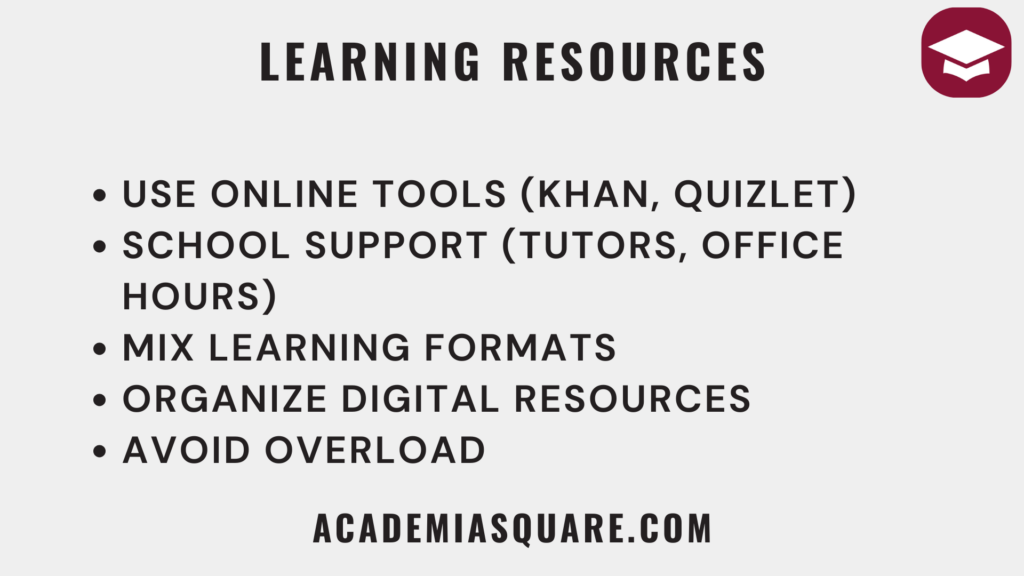
Many students try to improve their grades by simply studying harder, but not necessarily smarter. If you’re only using your class notes and textbook, you’re missing out on a world of tools designed to make learning easier and more effective. Knowing how and when to use the right educational resources can provide a huge advantage—especially when you’re trying to boost grades quickly and efficiently.
Today’s academic world offers more learning resources than ever: tutoring centers, online platforms, apps, forums, open educational videos, and more. However, not all resources are created equal. This chapter focuses on how to identify, choose, and use high-impact tools that support your learning goals.
Why External Resources Help Improve Your Grades
Sometimes a teacher’s explanation just doesn’t click—and that’s okay. The way information is delivered makes a huge difference. A concept that seems confusing in class might make perfect sense when explained differently in a video or one-on-one session. Research from the National Tutoring Association confirms that students who use multiple modes of instruction tend to show significantly higher improvement in academic performance.
By seeking out additional resources, you:
- Reinforce what you’ve learned in class
- Fill knowledge gaps before they widen
- Discover alternative explanations that match your learning style
- Build confidence by mastering difficult topics independently
Top Resources to Help You Get Better Grades
Here’s a list of valuable tools and where they work best:
- Khan Academy: Great for math, science, and economics—free, clear, and widely trusted
- Quizlet: For flashcard-based learning and test prep (great for vocabulary-heavy subjects)
- YouTube Channels: CrashCourse, The Organic Chemistry Tutor, and others offer engaging and digestible explanations
- Chegg & Course Hero: Use for practice problems and study guides—avoid using them just for shortcuts
- Wolfram Alpha: Ideal for solving math problems with step-by-step breakdowns
Whenever you use external help, make sure you’re still engaging with the content—don’t just memorize answers. The goal is understanding, not shortcuts.
How to Use School Resources to Improve Your Grades
Your school likely offers free academic support that you’re not taking advantage of. From writing centers to TA office hours, these are high-impact options that are often underused.
- Visit tutoring centers: Especially useful for math, writing, and sciences
- Attend office hours: Ask questions, get feedback, and show initiative
- Join or form study groups: Collaborative learning can help solidify concepts and expose you to different problem-solving methods
- Request extra practice material: Instructors are often willing to provide more if asked
Being proactive not only helps you academically—it also shows teachers that you’re engaged and committed, which can positively affect grading in borderline cases.
Stay Organized When Using Multiple Resources
One of the risks of using multiple tools is becoming overwhelmed. Keep track of what you’re using and why. Create folders, save links, and build a system so you don’t waste time searching for material later.
Try using tools like:
- Notion or OneNote to collect notes and videos
- Bookmark folders by subject
- A Google Doc with links and short summaries of each resource
Remember, it’s not just about collecting more content—it’s about using it strategically to boost your grades in a focused way. Supplement, don’t overload.
By leveraging the right learning resources and tools, you turn frustration into clarity—and wasted time into measurable academic improvement.
Test-Taking Strategies That Will Help You Get Better Grades
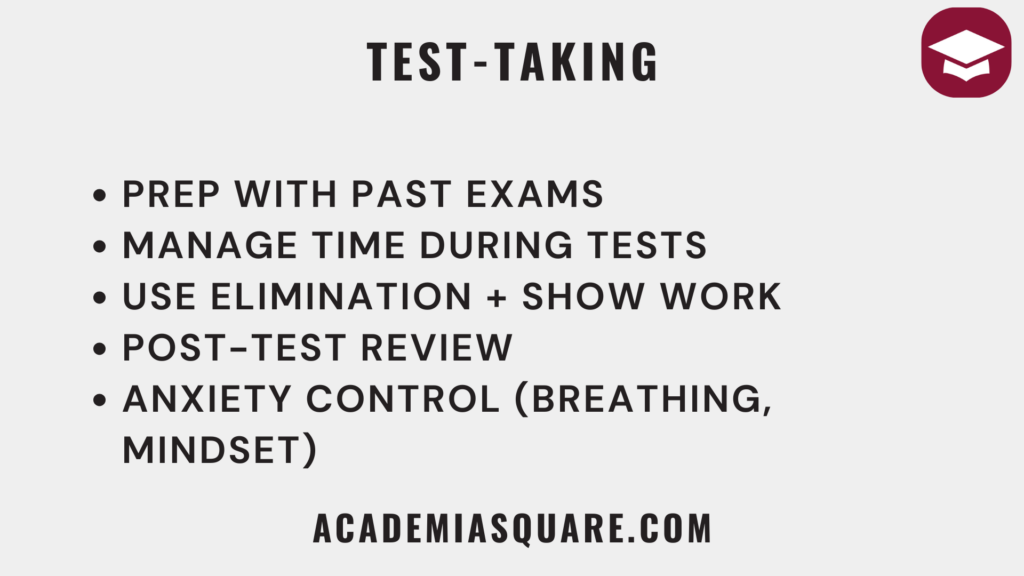
Knowing the material is only half the battle—doing well on tests requires a different set of skills. Students often understand content in practice but struggle during exams due to poor strategy, anxiety, or lack of preparation. Learning effective test-taking strategies is crucial if you’re serious about getting better grades fast.
According to the American Test Anxieties Association, over 50% of students experience performance anxiety that negatively impacts their scores. The good news? Much of that can be improved through preparation and technique.
Before the Exam: Strategic Preparation to Improve Your Grades
Start preparing early and use active methods:
- Use past papers or old tests to simulate real exam conditions
- Create practice questions based on class material
- Review the syllabus to identify what’s most likely to be tested
- Teach key concepts to someone else
Don’t just passively review. Active recall and spaced repetition are proven methods to boost long-term retention and prepare your mind for the type of questions that will be asked.
Test-Taking Techniques That Help You Get Better Grades
Here are several proven methods to maximize performance during the actual exam:
- Scan the test first: Quickly look through all questions and mark easy ones to answer first
- Manage time wisely: Don’t get stuck—move on and return later if needed
- Use elimination: For multiple choice, eliminate obviously wrong answers before choosing
- Show your work: Especially in math or science exams—partial credit matters
- Underline keywords: In essay or short-answer prompts, mark important terms to stay focused
Confidence plays a big role. Use controlled breathing techniques to lower anxiety and keep your brain in problem-solving mode.
After the Test: Learn From Mistakes to Improve Your Grades
Once your test is returned, don’t just glance at the grade—study it. Analyzing what you got wrong helps you avoid the same mistakes next time and gives insight into patterns of misunderstanding.
Here’s a post-test analysis checklist:
- Identify what type of questions you missed (e.g., factual, conceptual, time management)
- Note if certain topics keep tripping you up
- Ask the instructor for feedback on unclear points
- Update your study plan based on weaknesses
This process turns every test into a powerful learning opportunity. In fact, students who review their incorrect answers carefully tend to see major improvement on future exams—often by a full letter grade.
Mastering test-taking isn’t about tricks or shortcuts—it’s about understanding the game, preparing smartly, and showing what you know. These habits, when combined with content mastery, can significantly help you get better grades in any subject.
Enhancing Reading and Comprehension
Whether you’re in high school or college, reading is a major part of your academic life. But simply reading more doesn’t automatically mean you’ll improve your grades. What truly matters is how you read. Most students never learn how to read strategically—so they get overwhelmed, bored, or forget everything by the next day.
To succeed academically, you need to develop smarter reading and comprehension techniques. These help you extract meaning efficiently, retain information longer, and prepare more effectively for exams and essays.
Why Smarter Reading Helps You Improve Your Grades
Reading with intention is about quality, not quantity. According to a study published in Reading Research Quarterly, students who used strategic reading methods performed significantly better in comprehension and test accuracy than those who read passively. So, the key is to read less—but better.
Smarter reading helps you:
- Identify key concepts quickly
- Retain information longer with deeper understanding
- Prepare for tests and class discussions more efficiently
- Feel less overwhelmed when assigned large reading loads
Previewing Texts to Improve Comprehension
Before diving into a reading, always preview it. This technique sets a mental roadmap and improves your ability to absorb and organize the material. It’s part of the SQ3R method (Survey, Question, Read, Recite, Review), which has been proven to enhance retention.
Here’s how to preview effectively:
- Scan headings, subheadings, bold terms, and summaries
- Look at any graphs, images, or sidebars
- Skim the introduction and conclusion for the main argument or thesis
This helps you know what to expect and what to look for as you read.
Active Reading Techniques to Boost Your Grades
To make your reading sessions more effective, try these active strategies:
- Ask questions: Turn section titles into questions and try to answer them while reading
- Highlight selectively: Only underline keywords, definitions, or turning points—avoid entire paragraphs
- Annotate margins: Write comments, summaries, or reactions next to the text
- Summarize in your own words: After each section, pause and write a brief summary without looking back
These techniques engage your brain on multiple levels, increasing both focus and memory retention.
Use the “Teach-Back” Method to Reinforce Comprehension
If you really want to know whether you understand a passage, try explaining it aloud to someone—or to yourself. This is called the “teach-back” method. If you can summarize a chapter clearly and accurately without peeking, you’ve truly mastered it.
This method is especially helpful when studying for essay-based exams or literature classes that require deep understanding, not just memorization.
Tools That Support Better Reading and Study Habits
If you’re dealing with dense academic material, technology can help:
- Speechify or NaturalReader: Turn readings into audio format and listen while reviewing notes
- Hypothesis: A browser plugin that lets you annotate and highlight web texts collaboratively
- Readwise: For organizing and revisiting highlights from eBooks, articles, and PDFs
By combining active reading habits with the right tools, you transform your study sessions into high-performance learning experiences—and start to improve your grades almost immediately.
Building Strong Relationships with Educators
Many students overlook one of the simplest, most powerful ways to get better grades: building a respectful, professional relationship with your instructors. Whether you’re in school or college, your teachers can offer insights, clarify concepts, and even provide additional help—if you’re willing to ask.
According to a study published in the Journal of Educational Psychology, students who actively engage with their teachers perform better, have greater academic confidence, and are more likely to persist in difficult courses. So, don’t sit in the back row silently—engagement matters.
Why Teacher Relationships Matter If You Want to Improve Your Grades
When teachers see that you’re genuinely invested, they tend to:
- Offer clearer feedback and additional explanations
- Be more responsive to your questions or emails
- Give guidance on how to improve specific areas
- Provide helpful resources or extra credit opportunities
Instructors are often more flexible with students who show effort, even if their grades are borderline. That relationship can make a big difference when final grades are tallied.
Ways to Engage Positively with Your Instructors
Building a connection doesn’t mean being a teacher’s pet—it means showing initiative and respect. Try these strategies:
- Ask thoughtful questions: Before, during, or after class
- Visit office hours: Prepare questions in advance to make the most of their time
- Email with purpose: Be clear, polite, and specific when asking for help
- Participate in class: Speak up during discussions or offer insights
These actions signal that you’re serious about learning and actively trying to improve your academic performance.
Ask for Feedback to Get Better Grades
One of the most valuable questions you can ask a teacher is: “What can I do to improve my work?” Most students avoid this because they’re afraid of hearing criticism—but this kind of feedback is gold. It shows maturity, openness, and a willingness to grow.
Tips for asking for feedback:
- Be specific: “What did you think of my argument in paragraph three?”
- Be open: Don’t defend your work—listen and learn
- Be timely: Ask soon after the assignment is returned
Build Trust and Reliability Over Time
Relationships are built on consistency. Arrive on time, meet deadlines, show that you care. Teachers remember students who put in effort, and they’re more likely to offer help or support to those who show up and stay involved.
In the long run, strong teacher relationships do more than improve your grades—they open doors to recommendation letters, mentorship, and opportunities that extend far beyond the classroom.
Setting and Tracking Academic Goals
Most students want to improve their grades, but few take the time to define what that actually means. Vague intentions like “do better in school” or “study more” rarely lead to real progress. Academic success requires clarity, direction, and strategy—which starts with goal setting. When you have specific, measurable goals, you turn your ambitions into a roadmap.
According to educational psychology research, students who set academic goals consistently outperform those who don’t. Goal-setting builds motivation, sharpens focus, and provides a way to measure progress—all of which contribute directly to better grades.
Why Goal-Setting Is Essential to Improve Your Grades
Goals create structure. They help you break big academic challenges into manageable steps, making success feel achievable. Without clear goals, it’s easy to waste time or get discouraged by slow progress. With them, you gain momentum—and clarity about where to focus your energy.
Benefits of academic goal-setting include:
- Improved time and task management
- Greater academic confidence and motivation
- Higher GPA and exam performance over time
- Better self-monitoring and accountability
Use SMART Goals to Get Better Grades
The SMART framework ensures your goals are well-defined and actionable:
- S: Specific – Define exactly what you want to accomplish (“Raise my math grade from C to B”)
- M: Measurable – Trackable progress (e.g., “Score at least 80% on all quizzes”)
- A: Achievable – Set realistic goals based on your current situation
- R: Relevant – Tie goals to your long-term academic or career plans
- T: Time-bound – Set a deadline (“By the end of the semester”)
This structure keeps you accountable and focused. Avoid general goals like “study more”—instead, say, “Study biology for 30 minutes every day at 5 PM.”
Break Down Goals into Weekly and Daily Tasks
Big goals can feel overwhelming. The trick is to break them into smaller milestones:
- Long-term: Raise your GPA by 0.5 over the semester
- Medium-term: Score 85% or higher on the next two exams
- Short-term: Review two chapters this week and complete practice questions
Use planners, apps like Todoist, or a simple notebook to track progress. Regular check-ins help you adjust your plan and stay on track.
Track Progress and Adjust Goals Strategically
Once you start working toward a goal, monitor your results weekly. Are your grades improving? Are your habits sticking? If not, make small adjustments—don’t abandon the goal. Reflecting on your own performance makes your plan dynamic and responsive.
Ask yourself weekly:
- What did I accomplish this week?
- What didn’t work, and why?
- What can I improve or adjust for next week?
When you track and refine your academic goals, you take control of your performance. It’s one of the most practical and powerful ways to improve your grades consistently across subjects.
How Technology Can Help You Get Better Grades Quickly
In today’s digital world, technology is more than just entertainment—it’s a powerful academic ally. If you’re asking how to improve your grades fast, one of the smartest moves you can make is to leverage apps, platforms, and devices to enhance your study routine. When used correctly, tech tools can make learning more efficient, organized, and engaging.
According to EDUCAUSE research, students who integrate digital tools into their learning process tend to experience increased retention, better grades, and higher satisfaction with their studies.
Productivity Tools That Help Improve Your Grades
Keeping your academic life organized is essential. These tools can help you stay on track:
- Notion: For planning your coursework, notes, to-do lists, and weekly schedules
- Google Calendar: Set reminders for assignments, quizzes, and study sessions
- Forest: A Pomodoro timer that helps you stay focused by “growing” a virtual tree
- Trello or Todoist: Task managers to break down assignments into daily actions
With these platforms, you can easily track progress, reduce procrastination, and feel more in control of your time—one of the core drivers of academic success.
Study Apps That Make Learning Faster and Easier
If you want to get better grades without doubling your study hours, consider using intelligent learning tools:
- Anki: A flashcard app that uses spaced repetition to boost long-term memory
- Quizlet: Create or access millions of pre-made study sets by topic
- Grammarly: Helps with grammar, structure, and clarity in your writing assignments
- Photomath or Wolfram Alpha: Solve complex math problems with step-by-step solutions
These apps are especially helpful for subjects like science, language learning, writing, and math. They streamline difficult concepts and help you study smarter, not harder.
Digital Note-Taking and Resource Management
Taking effective notes—and keeping them organized—is easier with digital tools:
- OneNote: Great for handwritten or typed notes, organized by subject
- Evernote: Store PDFs, links, voice memos, and class notes all in one place
- Google Docs: Ideal for collaborating with classmates or working on group projects
Searchable, sharable, and backed up—digital notes prevent last-minute panic and reduce time spent hunting for materials during exam season.
Tech Boundaries: Use Devices to Help, Not Hinder
Technology can be your best friend or your biggest distraction. Social media, games, and constant notifications destroy focus. If you want tech to help you get better grades, you must control how and when you use it.
Best practices for healthy tech use:
- Turn off non-essential notifications during study sessions
- Use full-screen mode to limit distractions while writing or researching
- Schedule screen-free breaks to reduce burnout
With the right balance, technology can supercharge your academic performance, helping you achieve better grades with less stress. It’s not about doing more—it’s about using the tools you already have, smarter.
Sources and Recommended Reading on How to Improve Your Grades
- Dunlosky, J., Rawson, K.A., Marsh, E.J., Nathan, M.J., & Willingham, D.T. (2013). Improving Students’ Learning With Effective Learning Techniques. Psychological Science in the Public Interest, 14(1), 4–58. – Comprehensive review of evidence-based learning strategies like retrieval practice and spaced repetition.
- American Psychological Association: Educational Psychology Promotes Teaching and Learning – Overview of how psychological science enhances educational practices and student success.
- UNC Learning Center: Studying 101 – Study Smarter Not Harder – Practical advice on effective study habits, including distributed practice and active recall.
- Stanford University: Studying More Strategically Equals Improved Exam Scores – Research highlighting the benefits of strategic study approaches over increased study time.
- Psychology.org: Introduction to Educational Psychology Theory – Insights into how educational psychology informs teaching methods and learning outcomes.
- Princeton University McGraw Center: 7 Strategies for Success – Guidance on goal setting, time management, and active learning techniques.
- University of Washington: Catalyze Your Success – Learning Strategies for Students – Tips on developing effective learning strategies tailored to individual needs.
- Emerald Insight: The Impact of Learning Strategies on Academic Achievement – Study examining how specific learning strategies affect student performance.
- AcademiaSquare: SQ3R Method Guide – Detailed explanation of the SQ3R reading comprehension technique to enhance understanding and retention.
- AcademiaSquare: 10 Effective Study Techniques Every Student Should Know – Compilation of proven study methods to boost academic performance.


